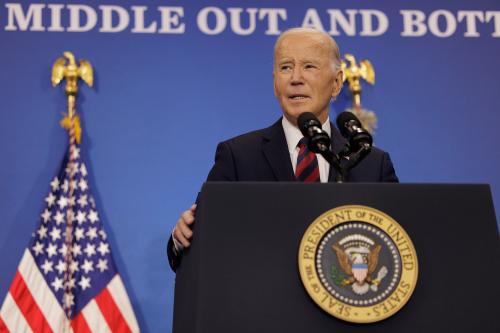Big Tech has enabled unparalleled reach, engagement, and innovation in the news media even as the decoupling of advertising and journalism has threatened the very foundation of a commercial news model and ushered in the era of disinformation. Lawmakers in the U.S. now appear poised to join in efforts around the world aimed at rebalancing the codependent relationship between Big Tech and news publishers with the release of an updated Senate bill enabling small news organizations to negotiate compensation from tech giants like Meta and Google that appears to have bi-partisan and bi-cameral support.
More than a year after Australia adopted a pioneering new media bargaining code and the EU Copyright Directive went into effect, the idea of getting Big Tech to pay for the news they use is gaining greater support around the world, with lawmakers in Brazil, Canada, India, Indonesia, Sweden, the U.S., and the U.K. exploring interventions that they hope will support an industry facing an extinction event yet recognized as essential to democratic governance. Governments are also considering whether competition policy should be deployed to claw back revenue from tech behemoths and the AdTech infrastructure they control or to enable news media to collectively bargain with aggregators and other platforms that use their content.
Three policy arenas
These legal regulatory efforts have coalesced around three dominant types of interventions: taxation, competition/antitrust, and intellectual property. The building blocks include:
- Allowing publishers to collectively bargain without violating antitrust laws
- Requiring platforms negotiate with publishers for the use of news snippets
- Requiring platforms to pay licensing fees to publishers
- Taxing digital advertising and using the resulting revenues to subsidize news outlets
Australia’s 2021 news media bargaining code compels platforms to negotiate payment to media outlets for using their content, and despite criticism that it amounted to a Big Tech subsidy to Big Media given extensive lobbying by media mogul Rupert Murdoch, the law has also rejuvenated the country’s journalism sector. Australian media outlets large and small have benefitted and new journalism jobs are being created in a sector that lost thousands of opportunities during the coronavirus pandemic – though the lack of transparency into the commercial deals negotiated between publishers and platforms remains problematic.
Meanwhile, India’s competition authority has opened an inquiry of its own following an antitrust complaint filed by digital publishers earlier this year claiming that Google unfairly dominates the news aggregator business and does not allow publishers to competitively earn revenue on ads due to a “lack of transparency and information asymmetry.”
The Indian government may not wait for the enquiry before acting. Minister of State for Electronics and Information Technology, Rajeev Chandrasekha, said late last month that the government is looking at updating the IT law to address anti-competitiveness in the AdTech market, as well as requiring compensation for publishers when online services use their content to populate their platforms and profits. India, which has relentlessly pressured online platforms to promote politically favorable content and suppress critical opposition, is one of a handful of countries in the Global South that has both the expertise, user base, and regulatory influence to pursue the Australian strategy.
One of the thorniest challenges to pursuing these policies in any country is deciding what counts as journalism and which news organizations should benefit. Concerns that small outlets will get left behind in the commercial deals negotiated between large publishing conglomerates and Big Tech have plagued efforts to pass similar laws elsewhere. A perception that Murdoch’s media empire was the main beneficiary in Australia prompted independent media in Brazil to align with Google and Facebook to oppose similar legislation there, while in Canada a coalition of small, independent publishers called out secret back room deals in its push for amendments to the Canadian Online News Act. These and other issues are suggesting that journalists will not actually benefit from this type of arrangement and will be left behind.
In addition to these concerns around anti-competitive behaviors, lawmakers across the globe have also recognized the massive financial and editorial impacts that major tweaks to platform algorithms or priorities can have on news organizations, including drops in revenue, closures and layoffs, and the impact on news readers and subscribers who are forced to rely on information provided by dominant Big Tech platforms, even when that turns out to be a lie. From Facebook’s infamous pivot to video to its decision to de-prioritize professionally produced media content in favor of so-called meaningful content from friends, to its most recent shift to TikTok-style content, news organizations have been coerced into realigning their priorities and budgets. For example, Australia’s law includes requirements that platforms give advance notice to media outlets of major algorithmic changes (despite the problematic ambiguity of this concept) that could significantly impact their visibility and viability, and India’s publishers are seeking the same. Of course, these requirements will have little impact on news media revenue if Facebook moves ahead with its pivot away from news reporting.
Unlike other countries, European regulators have tried another approach to renegotiating power dynamics through updates to intellectual property law. The European Union (EU) Copyright Directive created a right for publishers, not just authors, to claim copyright and thus to allow news outlets to be remunerated when online service providers use their content. This concept of “ancillary copyright” or “neighboring rights” creates a framework for news media to negotiate licensing fees with platforms that use their content.
Until recently, the U.S. was also exploring whether a new approach to copyright along the lines of Europe’s was needed, but seems unlikely to pursue it after a report this summer by the Copyright Office recommended against it. It found that national copyright laws already provide some protections to publishers (which were missing in the EU prior to its Copyright Directive) and that revising copyright would do little to address market imbalances that make it difficult for news publishers to effectively negotiate licensing fees with Big Tech.
Parasitic or Symbiotic?
Ultimately the crux of this love-hate relationship between Big Tech and traditional news media is the fact that search engines, timelines, and news aggregators are filled with headlines, news snippets, and images culled from publishers and authors, typically without permission or payment, leading many publishers to argue that this use allows Big Tech to profit from news content produced by others without having to pay for it.
Although the “fair use” exception in copyright law typically permits the use of small amounts of copyrighted material under certain conditions without prior permission of the copyright holder, the question of whether this applies to news aggregators and the world’s most profitable online platforms remains unsettled. And despite critics’ assertions that imposing a “link tax” would undermine the free flow of information online and break the very foundations of the open and interoperable internet, this hasn’t happened yet.
The devil in the details
To pursue any of these policies, a country needs a robust ecosystem of existing legal frameworks, digital rights management entities, and organized civil society that includes independent professional associations, digital rights groups, and public interest lawyers. A digital rights management system must be developed and a designated third party must collect and distribute the licensing fees. Rights holders must be plugged into this system and trust the collecting organizations to benefit. Definitions of journalism and news media become vital and controversial in such instances.
The question of who benefits and how to distribute fees to small publishers, as well as to the journalists who actually author stories, is a challenge even in advanced economies and robust democracies, not to mention those where media capture is endemic or press freedom is limited. Pursuing any of these policies requires not only political will and technical expertise, but also complex institutional design, legitimacy, and trust.
Which is why the idea of taxing digital advertising could be more attractive and easier to implement, though figuring out which news outlets should benefit would be no easy task.
Taxing Tech to Fund Journalism
Given that digital advertising has generated record-breaking profits for Big Tech companies, like Google and now Meta (formerly known as Facebook), and that many people use these platforms to access news content produced by publishers, ideas on how to redistribute some of this wealth has attracted interest from publishers and policymakers. Especially since the duopoly not only captures a majority of the digital advertising revenue worldwide, but also dominates the complex and opaque AdTech system that sits between advertisers and publishers; where intermediaries siphon off a third of the value of this advertising.
But experts are divided on how much publishers versus platforms benefit from the traffic generated by referrals from social media and news aggregators.
On the one hand, the headlines, photos, and snippets that show up in search results, social media feeds, and news aggregators may drive some traffic to publisher websites and potentially generate revenue. This is considered referral traffic, as opposed to direct or organic traffic to a publisher website, which is more lucrative and enables them to gather data on their users as well as to build trust and direct relationships.
On the other hand, news improves the quality of content on tech platforms whose aim is to keep users in their walled gardens for as long as possible. Competition authorities in India, the U.K., and elsewhere are investigating whether the use of snippets by tech platforms is a result of imbalanced bargaining power.
Improving transparency of this notoriously opaque market as well as competitiveness would help level the playing field and give the media a fighting chance to reclaim a share of the advertising pie. Disagreements about the value of news snippets and referral traffic, fair use, and anti-competitive conditions on tech platforms are accentuated by a lack of empirical data and a complex and opaque AdTech ecosystem dominated by Google and Meta. This means that there is a dearth of data to inform evidence-based policymaking. Public policy around the world is being made with limited evidence and insufficient understanding of causation or correlation.
As the U.S. Congress considers the current draft Journalism Competition and Preservation Act of 2021, opportunities exist to remedy the information gap. Mandated data collection and access related to the AdTech ecosystem and the relationship between traffic and monetization could be considered because without these crucial data, policymakers may end up making policy based on anecdotes and assumptions. Other industries with sensitive data and business secrets are nonetheless able to provide information in a way that improves accountability while respecting privacy, which shouldn’t be dismissed here. Mandating improved transparency of this notoriously opaque market as well as access to data held by the platforms would help level the playing field and give news media around the world a fighting chance.
Dr. Courtney C. Radsch is a fellow at the UCLA Institute for Technology, Law & Policy, where her research and teaching focuses on the nexus of tech, media, and rights.
Meta and Google are general, unrestricted donors to the Brookings Institution. The findings, interpretations and conclusion posted in this piece are solely those of the author and not influenced by any donation.
The Brookings Institution is committed to quality, independence, and impact.
We are supported by a diverse array of funders. In line with our values and policies, each Brookings publication represents the sole views of its author(s).








Commentary
Frenemies: Global approaches to rebalance the Big Tech v journalism relationship
August 29, 2022